Unidentified - South Africa
A place for temporarily storing messages about South African species until they are identified.
See Unidentified -General Page for an index of unidentified categories. Please make a point of looking through these messages to see if you can help identify any of them.
Rudman, W.B., 2001 (June 26) Unidentified - South Africa. [In] Sea Slug Forum. Australian Museum, Sydney. Available from http://www.seaslugforum.net/find/unidentsa
Related messages
Unidentified sea slug from South Africa
March 3, 2010
From: Neil Wiltshire
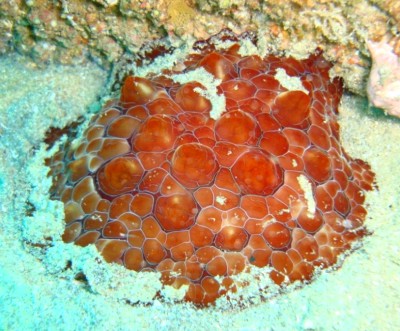
Dear Mr Rudman,
Further to my previous message, here is the second specimen of the unidentified sea slugs (pleurobranch's) I photographed recently.
As mentioned, I am not sure if this is a second species or a variant of the first species. [see message #23283]
Locality: Unnamed reef near Aliwal Shoal, off Umkomaas, south of Durban, 25 metres, KwaZulu-Natal south coast, South Africa, Indian Ocean, 24 January 2010, Flat sandy bottom, next to reef. Length: 150 mm. Photographer: Neil Wiltshire.
Thanks very much!
Best regards,
Neil
neilw@fcraft.co.za
Wiltshire, N.I., 2010 (Mar 3) Unidentified sea slug from South Africa. [Message in] Sea Slug Forum. Australian Museum, Sydney. Available from http://www.seaslugforum.net/find/23284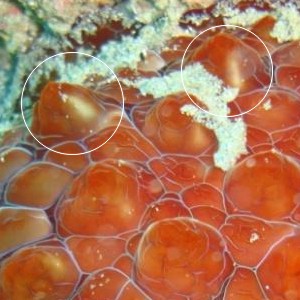
Dear Neil,
It certainly looks similar to the pleurobranch in your last message, but I have some doubts. One of the difficulties with identifying from photos is that I can't just turn the animal over and see if it is a pleurobranch or not. It has definite similarities to some dorid nudibranchs such as species of Hoplodoris, but in that group the bases of the tubercles are usually separated. If it is a pleurobranch then there is the possibility it is a large specimen of P. albiguttatus. One distinguishing feature of that species are the scattered tubercles it has, each with a triangular white mark on them. I have ringed two such white marks in the close-up alongside.
Unless you have another photo which shows the head tentacles I'm afraid I will have to leave this as an 'unknown'
Best wishes,
Bill Rudman
Unidentified dorid from Mozambique
May 30, 2008
From: Valda Fraser
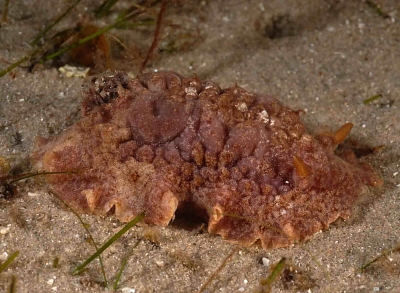
Dear Bill
An ugly, brown fellow on the prowl at night. The gills were not visible and I waited and waited. Eventually gave up, but decided to turn it over and photograph the underside. Maybe this will help with identification. Hope you can come up with a name.
Locality: Pomene, 2 m, Mozambique, Indian, 8 May 2008, Estuary. Length: 70 mm. Photographer: Valda Fraser.
Thanks.
Regards
Valda
valdafraser@mweb.co.za
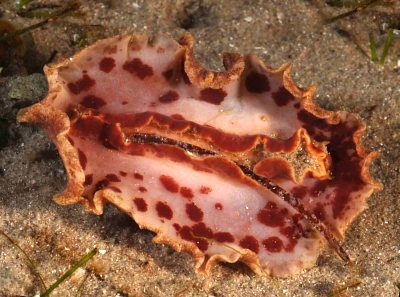
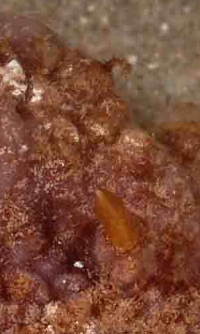
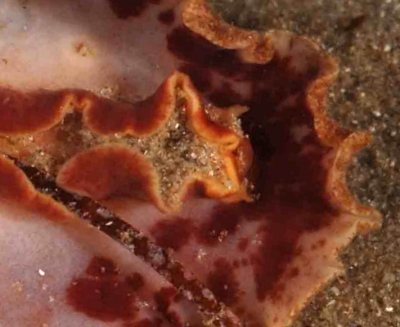
Dear Valda,
I thought at first this was very similar to Discodoris sp. 2, but then I noticed the dorsum is covered in large tubercles which appear to have a retractile papilla at the tip. Some of the tubercules appear to have a regular axial symmetry with rings of secondary rounded tubercules and ridges but I would need another photo to be sure. Hopefully one of the Californian group who have been looking at these 'flat' dorids will recognise it. The gills look as though it could be a species of Actinocyclus, but the mouth and head region looks quite different [see #14528].
Best wishes,
Bill Rudman
Striped dorid from South Africa eating what?
September 7, 2007
From: Valda Fraser
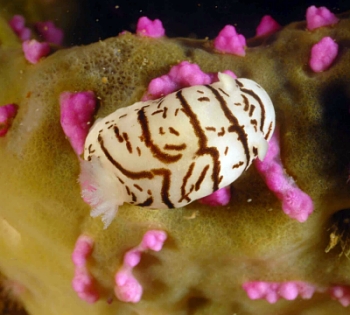
Dear Bill
In Jan 2001 you posted a message from me [#2670] with this fellow featuring as the star, Mr Stripey Dorid; a very common inhabitant in deeper water off KwaZulu-Natal and the Eastern Cape.
Locality: Pumula, KwaZulu-Natal, 42 m, South Africa, Indian, Jan 2007, Sponge on reef. Length: 15 mm. Photographer: Valda Fraser.
My question today relates to the sponge on which it and lots of others were feeding. What on earth is the pink "stuff" on the sponge? Please help.
Regards
Valda Fraser
valdafraser@mweb.co.za
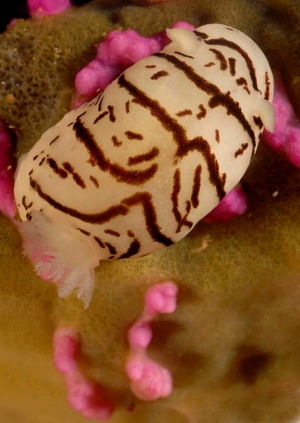
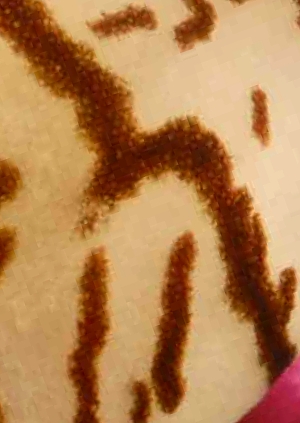
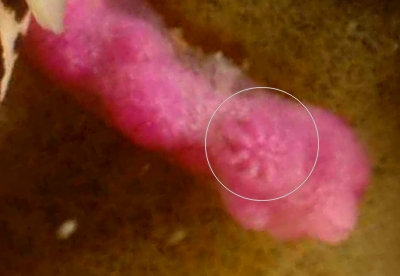
Dear Valda,
I am still no closer to a name for this animal. It certainly has some similarities to Paradoris sp 1 and Paradoris sp 2 but that doesn't get us far as I don't really know if they are really species of Paradoris. Perhaps Terry Gosliner's school of dorid experts can give us some comments.
Concerning the pink stuff. My first thought was an octocoral with retracted polyps and on close examination I found what looks like a semi-retracted polyp with 8 tentacles which would support my octocoral idea. If the dorid is eating the pink stuff, and if it is an octocoral, that would be interesting, as dorids don't normally feed on cnidarians
Best wishes,
Bill Rudman
Re: Possible Eubranchus from False Bay
June 11, 2007
From: Guido Zsilavecz
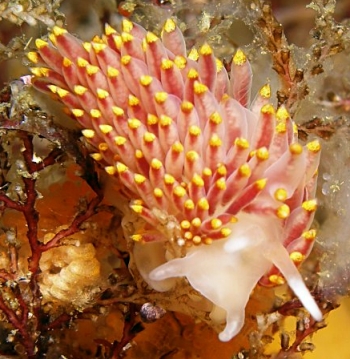
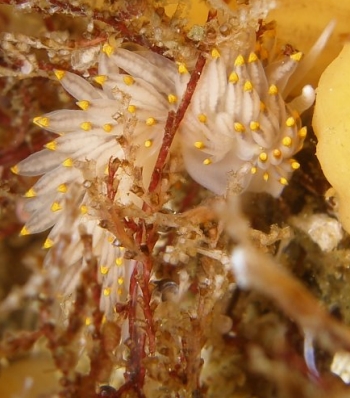
Hi Bill!
On a dive recently I also saw what I think may be a species of Eubranchus which is not in Gosliner, but looks similar to other Eubranchidae shown on this forum.
There were two varieties, one with red digestive tract extensions into the cerata, one with white. I found them close together, and with a number of egg ribbons, as can be seen in the group image. I have a close-up of the egg cases too, which I can send if needed.
Locality: Cape Town, 15 meters, South Africa, Atlantic Ocean, 9-April-2007, Hydroid colony on rock reef wall. Length: 15 mm. Photographer: Guido Zsilavecz.
Could this be a new species or is it familiar to you?
Thanks,
Guido
guido@surg.co.za
Zsilavecz, G., 2007 (Jun 11) Re: Possible Eubranchus from False Bay. [Message in] Sea Slug Forum. Australian Museum, Sydney. Available from http://www.seaslugforum.net/find/19954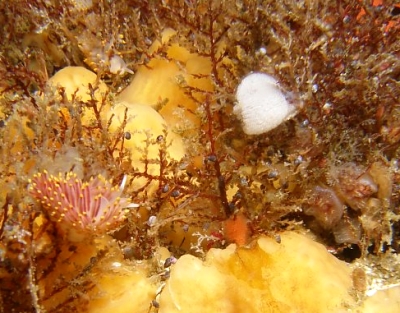
Dear Guido,
This is an aeolid but I don't think it is a eubranchid. From the way the cerata are arranged in many transverse rows, and the apparent lack of tentacle-like extensions to the anterior corners off the foot, my considered 'guess' is that it is a species of Cuthona.
I can't find - or recall - it, so perhaps it is an unnamed species. Perhaps Terry Gosliner can give us a comment.
Best wishes,
Bill Rudman
Possible Eubranchus from False Bay
May 25, 2007
From: Georgina Jones

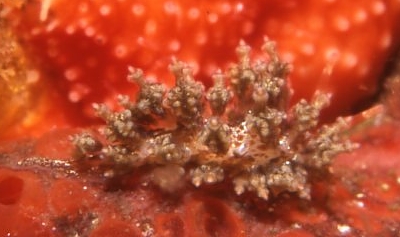
Dear Bill,
I found this small nudibranch the other day -- the photographs aren't fantastic, but I think it is a species of Eubranchus which doesn't appear in Gosliner's reference book. What do you think?
I have included a picture of the egg ribbon which were next to the nudis -- they weren't actually laying them, but I thought the proximity suggestive.
Locality: Cape Town, 13 m, South Africa, False Bay, 25 April 2007, rocky reef with heavy sponge encrustation. Length: 15 mm. Photographer: Georgina Jones.
Best wishes
Georgina Jones
gjones@icon.co.za
Jones, G.J., 2007 (May 25) Possible Eubranchus from False Bay. [Message in] Sea Slug Forum. Australian Museum, Sydney. Available from http://www.seaslugforum.net/find/19936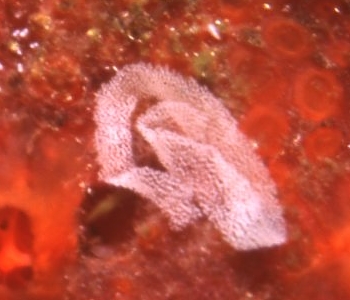
Dear Georgina,
It certainly looks like it could be a species of Eubranchus but I don't recognise the species. I've included the egg ribbon - but as you imply it may be nothing to do with the aeolid
Best wishes,
Bill Rudman
Unidentified dorid from Capetown, Sth Africa [1]
February 13, 2006
From: Andrew Taylor
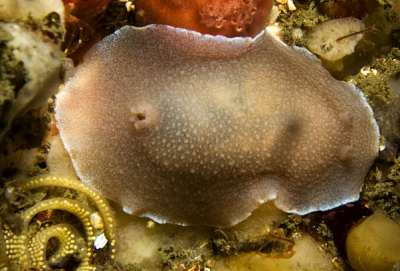
Hi Bill
Found these three [see also #15814; #15815] off the Atlantic seabord in Cape Town (between Hout Bay and Sandy Bay ) Depth was around 30m , sandy bottom with granite outcrops covered with sponges , soft corals and various algae .None of our local experts seem to be able to help with an ID.
Locality: Cape Town, 30m, Western Cape, Atlantic coast, 21 January 2006, Sandy bottom , rocky outcrops. Length: 25mm. Photographer: Andrew Taylor
Safe Diving
Andrew
andytuwphoto@gmail.com
Taylor, A.D., 2006 (Feb 13) Unidentified dorid from Capetown, Sth Africa [1]. [Message in] Sea Slug Forum. Australian Museum, Sydney. Available from http://www.seaslugforum.net/find/15813Dear Andrew,
In future can you split messages with 3 different species into 3 separate messages. It saves me a lot of time and allows me to arrange species more logically on the Forum.
I must say the egg ribbon on the bottom left of your photo is interesting, although we can't be sure it belongs to your animal. The eggs in it are quite big, suggesting the larvae may hatch out as crawling young slugs, rather than as swimming planktonic larvae, which is the fate of most nudibranch young.. Having said that, I'm afraid I haven't an answer for any of your 3 species! In the past I have put messages such as yours to one side until I can check them out or ask other experts for help. But in this case I think I'll try posting them and see if I anyone recognises them. We are building quite a pile of unidentified Sth African species, which is I guess not surprising, considering the the mix of animals from the tropical Indian Ocean, and the cooler Atlantic, as well as an endemic cool temperate fauna - and so little work being done on the fauna - despite the sterling efforts of Terry Gosliner.
Hopefully in can give us some clues
Best wishes,
Bill Rudman
Unidentified dorid from Capetown, Sth Africa [2]
February 13, 2006
From: Andrew Taylor
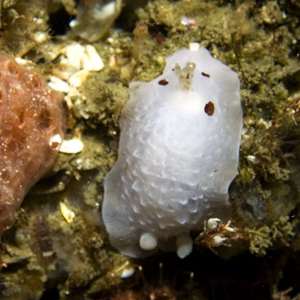
Hi Bill
Found these three [see also #15813; #15815] off the Atlantic seabord in Cape Town (between Hout Bay and Sandy Bay ) Depth was around 30m , sandy bottom with granite outcrops covered with sponges, soft corals and various algae .None of our local experts seem to be able to help with an ID.
Locality: Cape Town, 30m, Western Cape, Atlantic coast, 21 January 2006, Sandy bottom , rocky outcrops. Length: 25mm. Photographer: Andrew Taylor
Safe Diving
Andrew
andytuwphoto@gmail.com
Taylor, A, 2006 (Feb 13) Unidentified dorid from Capetown, Sth Africa [2]. [Message in] Sea Slug Forum. Australian Museum, Sydney. Available from http://www.seaslugforum.net/find/15814Dear Andrew,
There have many a number of black-spotted dorids reported from South Africa [see #14763] but none seem to fit this animal. Most are either species with bristles [caryophyllidia] on their back [Gargamella, Rostanga] or are smooth [Dendrodoris]. Your animal with raised tubercles is quite different. Again, I hope someone will recognise it
Best wishes,
Bill Rudman
Unidentified dorid from Capetown, Sth Africa [3]
February 13, 2006
From: Andrew Taylor
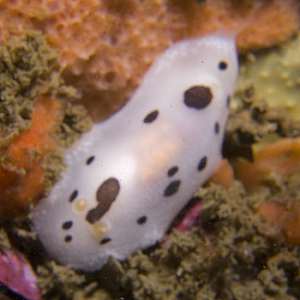
Hi Bill
Found these three [see also 15813; #15814] off the Atlantic seabord in Cape Town (between Hout Bay and Sandy Bay ) Depth was around 30m , sandy bottom with granite outcrops covered with sponges , soft corals and various algae. None of our local experts seem to be able to help with an ID.
Locality: Cape Town, 30m, Western Cape, Atlantic coast, 21 January 2006, Sandy bottom , rocky outcrops. Length: 25mm. Photographer: Andrew Taylor
Safe Diving
Andrew
andytuwphoto@gmail.com
Taylor, A, 2006 (Feb 13) Unidentified dorid from Capetown, Sth Africa [3]. [Message in] Sea Slug Forum. Australian Museum, Sydney. Available from http://www.seaslugforum.net/find/15815Dear Andrew,
There have many a number of black-spotted dorids reported from South Africa [see #14763] but none seem to fit this animal. Most are either species with bristles [caryophyllidia] on their back [Gargamella, Rostanga] or are smooth [Dendrodoris, Aphelodoris].
I can see the hint of little tubercles on the mantle in your photo so it is possible it is a species of Rostanga but the spots are much larger than the species I know from Sth Africa. Again, I hope someone will recognise it
Best wishes,
Bill Rudman
Unknown dorid - Gargamella? - from Sth Africa
September 16, 2005
From: Charles Rowe
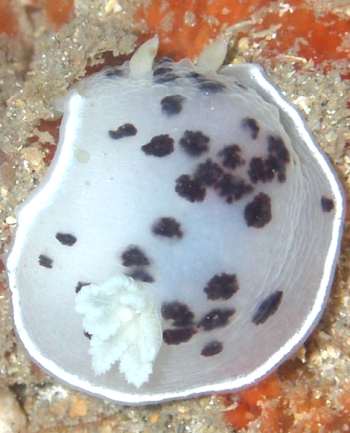
Hi Bill,
Here is a nudi from our wreck in Algoa Bay. This one makes 5 different nudis from a very small site indeed! This one was spotted on the sand next to the wreck in about 20 metres on its own. It was about 40 mm long.
Haerlem Wreck Algoa Bay, Port Elizabeth, South Africa, 25 metres, 40 mm long., Indian Ocean. Photographer: Charles Rowe
Since buying my new camera an Olympus 7070 I have been able to enlarge my shots quite a bit more and in doing so I am amazed to see that some nudis are bumpy! That is to say the epidermis is not smooth but almost warty. Very interesting.
See ya.
Charles
Charles.Rowe@gmsa.com
Rowe, C., 2005 (Sep 16) Unknown dorid - Gargamella? - from Sth Africa. [Message in] Sea Slug Forum. Australian Museum, Sydney. Available from http://www.seaslugforum.net/find/14763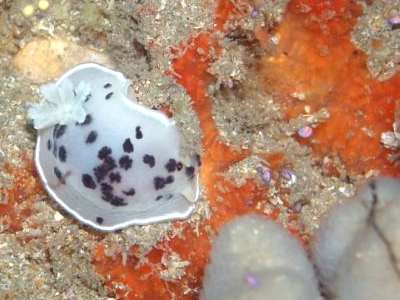
Dear Charles,
Thanks for this. We already have a message about this from Valda Fraser [#4866]. There are a number of whitish dorids with blackish or dark brown spots from Sth Africa, including a new species of Gargamella. However, none of them seem to have the distinctive opaque white submarginal line around the mantle border which is so distinctive in both your photos and Valda Fraser's. There is also Aphelodoris sp. 4 but it is an opaque white and the rhinophores are black. May be Terry Gosliner will recognise it for us
Best wishes,
Bill Rudman
Re: Stripy dorid from South Africa
January 6, 2004
From: Riaan Marx
Hi Bill and Valda,
I am by no means an expert in identifying these critters but doesn't this "cute fatty" look much like Phyllidia zebrina?
Regards
Riaan Marx.
rmarx@ms.cs.co.za
Marx, R., 2004 (Jan 6) Re: Stripy dorid from South Africa. [Message in] Sea Slug Forum. Australian Museum, Sydney. Available from http://www.seaslugforum.net/find/11778Dear Riaan,
It certainly looks like Phyllidia zebrina but Valda's animals seems to have a circle of gills on the back which cancels out the phyllidiids as a possibility.
Thanks for checking out the 'unidentified'
Bill Rudman
Armina from South Africa
October 1, 2002
From: Valda Fraser
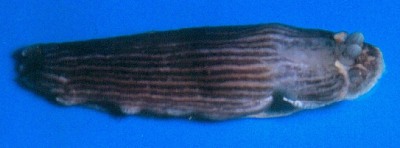
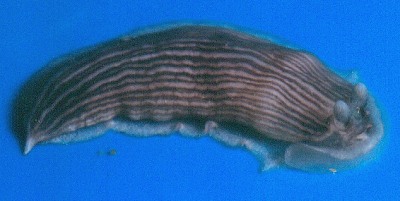
Dear Bill,
A friend at the Oceanographic Research Institute in Durban knows of my love of nudibranchs and called to tell me about some horrid beasts that had eaten all five sea pens (Virgularia sp.) that were being carefully nurtured. The sea pens died one after the other, and only when the tank was cleaned out, were the culprits found in the sand – alive and probably hungry! No one ever noticed the arminids feeding on the sea pens, so it seems that these animals are able to live permanently in the sand. Can you help with identification?
I am sending two images to illustrate colour variation. I especially chose the one photo as the animal has a “piece” missing.
Locality: Specimens taken off Durban, KwaZulu-Natal, South Africa, 25m
Date: August 2002
Size: About 15 mm
Regards
Valda Fraser
valdafraser@mweb.co.za
Fraser, V., 2002 (Oct 1) Armina from South Africa. [Message in] Sea Slug Forum. Australian Museum, Sydney. Available from http://www.seaslugforum.net/find/7814Dear Valda,
This is definitely a species of Armina, and eating sea pens is what they do. Species tend to be nocturnal so it is possible they did their damage after the people at the Oceanographic Institute had gone home for the night. I'm afraid the few species of Armina reported from South Africa were described from preserved animals so a name is not possible at present.
Best wishes,
Bill Rudman
South African dorid
September 6, 2001
From: Valda Fraser
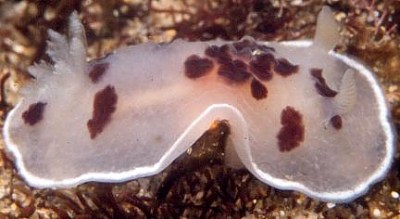
Dear Bill,
A small nudibranch who was not short of family as I saw quite a few here and there. I don't know whether it is a juvenile.
Locality: Brazenhead, Eastern Cape, SOUTH AFRICA, 25m
Date: July 2001
Size: 10mm
Thanks,
Valda Fraser
valdafraser@mweb.co.za
Fraser, V., 2001 (Sep 6) South African dorid. [Message in] Sea Slug Forum. Australian Museum, Sydney. Available from http://www.seaslugforum.net/find/4866Dear Valda,
I have kept this a while waiting for an inspiration to arrive. No luck. I have no idea what it is. Perhaps Terry Gosliner can help.
Best wishes,
Bill Rudman.
Dermatobranchus sp from South Africa
August 4, 2001
From: Valda Fraser
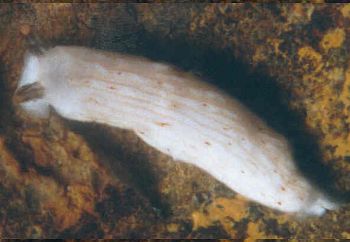
Dear Bill,
Another ugly one. Hope you will be able to identify it.
Thanks.
Locality: Park Rynie, south coast KwaZulu-Natal, SOUTH AFRICA, 32m
Date: September 2000
Size: 8mm
Regards,
Valda Fraser
valdafraser@mweb.co.za
Fraser, V., 2001 (Aug 4) Dermatobranchus sp from South Africa. [Message in] Sea Slug Forum. Australian Museum, Sydney. Available from http://www.seaslugforum.net/find/3041Dear Valda,
This is a species of Dermatobranchus. I'm afraid I could only guess at a name.
Best wishes,
Bill Rudman.
Stripy dorid from South Africa
January 28, 2001
From: Valda Fraser
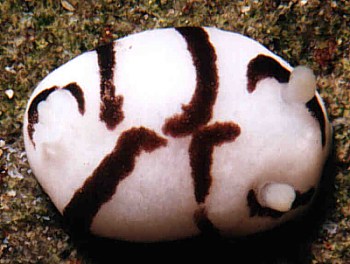
Dear Bill
A cute fatty! Please tell me what I should call him.
Locality: Brazen Head, Transkei, SOUTH AFRICA - 28m
Date: June 2000
Size: 15mm
Thanks.
Valda
iti04937@mweb.co.za
Dear Valda,
This is one I put aside some time ago because I thought I had seen a photo of it somewhere. Can you remember whether the mantle was smooth or whether it was covered with short bristles? [caryophyllidia] like Jorunna?
Best wishes,
Bill Rudman
Tritoniids from South Africa
January 5, 2001
From: Valda Fraser
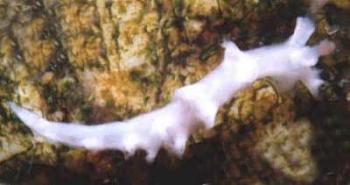
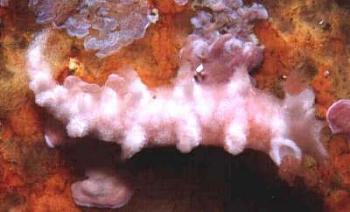
Dear Bill
These tiny ones appeared suddenly last July. Unfortunately they are the kind that drive me mad because I still have minimal success in photographing dull whitish animals. Anyway, I hope you can see enough to hazard a guess.
Locality: Umzumbe, KwaZulu-Natal, SOUTH AFRICA - 18m
Date: July 2000
Size: 10mm
Thanks.
Regards
Valda Fraser
iti04937@mweb.co.za
Fraser, V., 2001 (Jan 5) Tritoniids from South Africa. [Message in] Sea Slug Forum. Australian Museum, Sydney. Available from http://www.seaslugforum.net/find/2719Dear Valda,
I suspect these may be juveniles of two different species. The fact they are small and white and appeared suddenly at the same time suggests they are the result of late winter / early spring breeding. We get a similar influx of juveniles in August here is southeastern Australia.
Juvenile tritoniids have proved tricky to identify and in Europe the juveniles of the large common Tritonia hombergi were for many years considered to be a distinct species, the animal not getting its adult colouration until quite late in its development.
Best wishes,
Bill Rudman.
Re: elongate dorid from S.A.
October 6, 2000
From: Valda Fraser
Dear Bill
A quick note to answer your question. This nudibranch has no gills, I checked carefully.
Regards
Valda
valdafraser@mweb.co.za
Fraser, V., 2000 (Oct 6) Re: elongate dorid from S.A.. [Message in] Sea Slug Forum. Australian Museum, Sydney. Available from http://www.seaslugforum.net/find/3060Thanks Valda,
A very intersting animal
Bill Rudman.
Elongate dorid from South Africa
September 20, 2000
From: Valda Fraser
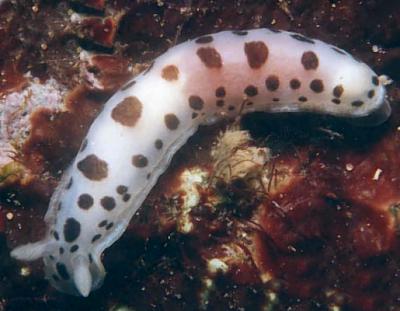
Dear Bill
A white nudibranch with black spots, but who is he? Hope you know! Tear yourself away from the Olympic action.
Locality: Park Rynie, south coast KwaZulu-Natal, SOUTH AFRICA, 28m
Date: September 2000
Size: 15mm
Thanks.
Valda
valdafraser@mweb.co.za
Fraser, V., 2000 (Sep 20) Elongate dorid from South Africa. [Message in] Sea Slug Forum. Australian Museum, Sydney. Available from http://www.seaslugforum.net/find/3039Dear Valda,
It's a bit hard to avoid the Olympics at the moment. Apart from the sport, there seems to be a marathon party going on in the streets of Sydney day and night as well.
Mind you this animal has taking my mind off the Olympics for a moment. It looks very interesting, but I am afraid I have no idea what it is. It seems to lack gills (or are the retracted?) and is very elongate. Perhaps a dendrodorid?
Best wishes,
Bill Rudman.
Unknown aeolid from South Africa
March 8, 2000
From: Valda Fraser
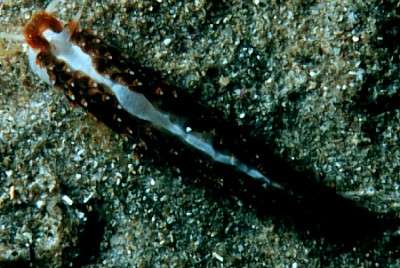
Dear Bill
I have taken photos of Moridilla brockii before and thought this was yet another specimen. On close examination, I realized that this nudibranch is something different. I hope you will be able to help with identification.
Locality: South Coast KwaZulu-Natal SOUTH AFRICA. Shelly Beach - 32m
Date: 27 Feb 2000
Size: 30mm
Regards
Valda Fraser
iti04937@mweb.co.za
Fraser, V., 2000 (Mar 8) Unknown aeolid from South Africa. [Message in] Sea Slug Forum. Australian Museum, Sydney. Available from http://www.seaslugforum.net/find/1996Dear Valda,
I think I have seen this before but I can't remember where. Let's see of someone can help.
Best wishes,
Bill Rudman.
Cratena from South Africa
March 6, 2000
From: Valda Fraser
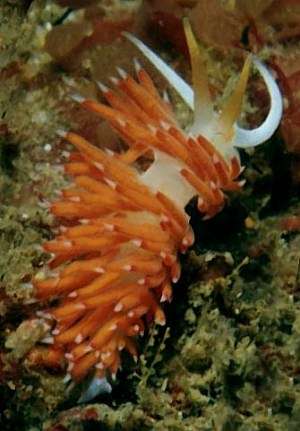
Dear Bill
I think this may be Cratena capensis. I look forward to hearing your opinion.
Locality: South Coast KwaZulu-Natal
Hibberdene - 20m
Date: June 1999
Size: 20mm
Regards
Valda Fraser
iti04937@mweb.co.za
Fraser, V., 2000 (Mar 6) Cratena from South Africa. [Message in] Sea Slug Forum. Australian Museum, Sydney. Available from http://www.seaslugforum.net/find/2020Dear Valda,
It could be Cratena capensis Barnard, 1927 but it is more likely to be Gosliner's Cratena sp. 1 which has rhinophores and oral tentacles of about equal length.
I can't see the 'black gland' below the tip of the cerata which Terry says is characteristic but then I can't see it in the photo in his book either. There is a darker region at the top of the digestive gland as in your photo. Another point si that Barnard says the rhinophores and oral tenatcles are white in Cratena capensis while in your animal (& Gosliner's) the rhinophores are orange.
Best wishes,
Bill Rudman.
